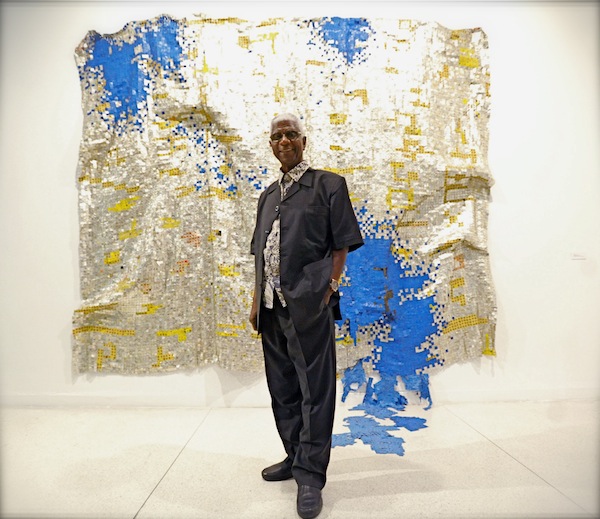
El Anatsui: Gravity and grace at the Bass Museum
By Sebastian Spreng, Visual Artist and Classical Music Writer
“It makes a little sound, like music,” the toddler whispers in her mother’s ear as she gazes, wide-eyed, engrossed, at El Anatsui’s gigantic piece, which seems about to devour her. And that gaze, which perceives the secret flutter, which sees better than any adult, is perhaps the best way to approach the works of this great African artist, now on display at Miami Beach’s Bass Museum of Art as part of the institution’s 50th anniversary celebration. Photo by World Red Eye
It would be more appropriate or much easier, to speak of the artist who was born 70 years ago in Ghana, worked as a teacher in Nigeria for decades, and is now hailed at biennials, festivals and museums, to speculate about the fascinating alchemy of his creative recycling, to theorize about his transformation of apocalyptic waste into pure beauty, or to note that while he cleans up the land, he makes what he collects into art in capital letters. His artwork looks like the product of a laborious task undertaken by ants united in a bid for massiveness, armed with mind-boggling imagination and imagery.
It is more gratifying to simply behold it, however, with the child-like bedazzlement that the first impression produces (bringing to mind the Monet image that gave a movement its name), bedazzlement that is a mixture of curiosity and astonishment, that sweeps you away, entranced by a work that rejoices in the combination of elements as local as they are global. “Paint your village and you paint the world” is a cliché, but an irrefutable one in the case of this artist, who from the depths of the Dark Continent unfurls his branches like a tree of life that, though made of dead matter, spreads out to all corners of the planet, just as the first men did.
The intrinsic and paradigmatic universality with which El Anatsui reclaims bottle caps, scraps of paper, jars and other waste materials – “junk nobody wants” – prompts viewers to play, to become participants (or protagonists, like the museum installers whom the artist asked to “sculpt” his pieces), to conduct a sacred and silent dialogue with the artwork. Then the resemblances and derivations start, the adventurous combinations that begin and end in each person’s imagination, because in truth the sculptures don’t resemble anything. It’s like the old game of I Spy.
Unimagined colors, shapes, compositions and strains of music that spark the urgency of the imagination, a game of dominoes á la Borges, with his gardens of East and West, that extends as far as García Márquez’s Macondo. It’s the red curtain of the Palais Garnier, the blue of Lake Atitlán, the glitter of Klimt, the mantles of El Greco, the woods of Mondrian, the vigor of Rothko. It’s the velvet sound of Berlioz and Wagner, the metal of Monteverdi’s, Balinese percussion and Ethiopian drums. It’s Byzantium; it’s dirt and dust; it’s gold tentacles, Tehuelche cloaks, ebony and lapis lazuli cardamons, torsos of swathed cyclops, the remains of fantastical animals, mummified by the sun, Ephesian columns, Tibetan mandalas, multicolored butterflies, the portals of Petra, the nets of Mediterranean fishermen and Indigo pirates, Agamemnon’s mask and pre-Columbian pectorals, Paul Klee’s antique sound, Namibia’s sands, Elliott Carter’s rain, Georgia O’Keefe’s desert, ocean binnacles, the maps of humanity’s memory, even one that could be that of the United States, coinciding capriciously in climate and color in the monumental piece Gravity and Grace, and so much more… all brought together, in a kind of Sunday on La Grande Jatte, by this modern Seurat, who strolls about strewing or stringing together tin petals and candies.
El Anatsui’s sculptures reflect “the weary weight of the world,” ensure we will never see garbage in the same way, give it a second chance, dignify and, elevate it. From the visual impact to the interplay of filigrees and textures, to the treatment of space and materials in a precise balance between lightness and heaviness, in that essential “invisible to the eye” that invites sound – “a little sound, like music” – it is an exhibit that must be seen by people of all ages because it has what so many contemporary art exhibits lack. It motivates, generates, inspires, entertains, resists labeling and completes a necessary cycle by transforming every visitor into an astonished child, by recovering the primal balance between Gravity and Grace.
GRAVITY AND GRACE: MONUMENTAL WORKS BY EL ANATSUI
April 11 to August 11, 2014
Recent Content
-
Artsarticle ·
-
Artsarticle ·
-
Artsarticle ·
